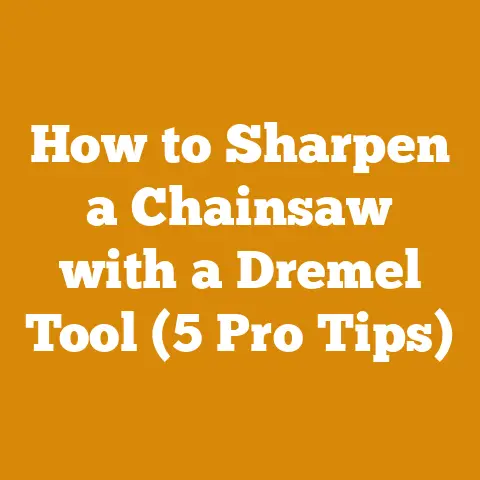Can You Burn Bradford Pear Wood? (5 Firewood Facts Revealed)
The adaptability of Bradford Pear trees, often seen gracing suburban landscapes with their spring blossoms, makes them a common candidate for firewood when they succumb to disease or storm damage. But can you burn Bradford Pear wood safely and efficiently? Let’s dive into the facts.
Can You Burn Bradford Pear Wood? (5 Firewood Facts Revealed)
As someone who’s spent years felling trees, splitting wood, and warming my home with the fruits of my labor, I’ve learned a thing or two about what makes good firewood and what doesn’t. Bradford Pear, with its tight grain and moderate density, presents an interesting case. While it’s not the worst wood you can burn, it’s certainly not the best. Let’s unpack why, and what you need to consider before tossing it into your fireplace or wood stove.
Fact #1: BTU Output and Heating Value – A Moderate Performer
The first thing I look at when evaluating firewood is its BTU (British Thermal Unit) output. BTU essentially measures the amount of heat a wood releases when burned. Higher BTU means more heat for your buck.
Bradford Pear wood falls into the moderate BTU range. Generally, it produces around 20 million BTUs per cord. To give you some context, hardwoods like oak and hickory can generate upwards of 25-30 million BTUs per cord. Softwoods like pine and fir are significantly lower, often below 20 million BTUs. This means you’ll need more Bradford Pear to achieve the same level of warmth as a denser hardwood.
- Data Point: According to the Firewood BTU Chart, Bradford Pear typically yields between 19 and 21 million BTUs per cord, depending on dryness and specific variety.
- My Experience: I once used a mix of Bradford Pear and oak to get through a particularly cold winter. I found myself feeding the fire more frequently with the pear wood, and the overall heat output wasn’t as consistent.
Cost Implications: Because you need more Bradford Pear wood to produce the same heat, the cost per BTU could be higher than with denser hardwoods, even if the initial price per cord is lower. Always consider the total heat output when comparing firewood prices.
Fact #2: Seasoning Time – The Key to Safe Burning
Seasoning firewood is crucial. Green wood contains a high percentage of moisture, which makes it difficult to burn efficiently and increases the risk of creosote buildup in your chimney. Creosote is a flammable substance that can lead to chimney fires, so proper seasoning is non-negotiable.
Bradford Pear, like many fruitwoods, needs a decent amount of seasoning. I recommend letting it dry for at least 6-12 months before burning. The exact time will depend on your climate, how you stack the wood (good airflow is essential), and the size of the splits.
- Data Point: Optimal moisture content for firewood is below 20%. You can use a moisture meter to check this.
- My Experience: I’ve learned the hard way about burning unseasoned wood. It smokes like crazy, produces very little heat, and leaves a tarry residue in your chimney. Now, I always test the moisture content before burning anything.
Cost of Seasoning: Seasoning doesn’t have a direct monetary cost, but it requires space and time. Consider the cost of storing the wood (tarps, shed space) and the opportunity cost of not being able to use the wood immediately.
Formula for Estimating Drying Time: Drying time (in months) ≈ (Initial moisture content – Target moisture content) / Drying rate. The drying rate varies based on climate and stacking method.
Fact #3: Smoke and Creosote – A Moderate Risk
Bradford Pear wood produces a moderate amount of smoke compared to other firewood options. While it’s not as smoky as softwoods like pine, it’s not as clean-burning as hardwoods like ash or maple. This means there’s a higher risk of creosote buildup, which, as I mentioned, is a fire hazard.
- Data Point: Regularly inspect and clean your chimney to prevent creosote buildup. The Chimney Safety Institute of America recommends annual inspections.
- My Experience: After burning a lot of fruitwood one year, I noticed a significant increase in creosote in my chimney. I had to call a professional chimney sweep to get it cleaned, which cost me around $200.
Cost of Chimney Maintenance: Factor in the cost of chimney inspections and cleanings when burning wood that produces a higher amount of smoke. Professional chimney sweeps typically charge between $150 and $300, depending on the complexity of the job.
Tip for Reducing Smoke: Ensure the wood is properly seasoned, and maintain a hot fire with good airflow. This will help burn off the volatile compounds that contribute to smoke.
Fact #4: Smell and Sparking – Pleasant Aroma, Occasional Sparks
One of the appealing aspects of burning Bradford Pear wood is its pleasant aroma. It has a slightly sweet, fruity scent that many people find enjoyable. However, it can also produce sparks, so it’s best to burn it in a closed fireplace or wood stove with a screen.
- Data Point: Fruitwoods, in general, tend to have a more fragrant aroma than other types of firewood.
- My Experience: I’ve enjoyed the smell of burning Bradford Pear on cool evenings. It adds a nice ambiance to the room.
Cost of Spark Prevention: If you don’t already have one, you may need to invest in a fireplace screen to prevent sparks from escaping. These screens can range in price from $50 to $200, depending on the style and quality.
Safety Tip: Never leave a fire unattended, especially when burning wood that tends to spark.
Fact #5: Availability and Price – Often Free, But Requires Work
Bradford Pear trees are common in many urban and suburban areas. This means you might be able to get the wood for free if a tree is being removed or has fallen in a storm. However, you’ll need to do the work of cutting, splitting, and seasoning the wood yourself.
- Data Point: The cost of firewood varies greatly depending on location, wood type, and availability. According to recent estimates, a cord of mixed hardwoods can cost anywhere from $150 to $400.
- My Experience: I’ve often salvaged Bradford Pear wood from neighbors who were having trees removed. It’s a great way to get free firewood, but it does require a significant time investment.
Cost of DIY Firewood Preparation:
- Chainsaw: A decent chainsaw will cost between $200 and $500. Consider brands like Stihl, Husqvarna, or Echo.
- Chainsaw Maintenance: Budget for chain sharpening (around $10-20 per sharpening), bar oil (around $10-20 per gallon), and fuel.
- Splitting Axe or Wood Splitter: A good splitting axe will cost around $50-100. A hydraulic wood splitter can range from $1,000 to $3,000.
- Safety Gear: Invest in safety glasses, gloves, and hearing protection. This will cost around $50-100.
- Labor: Your time is valuable! Estimate the number of hours you’ll spend cutting, splitting, and stacking the wood, and assign an hourly rate to it.
Case Study: Budgeting for DIY Firewood
Let’s say you decide to harvest a fallen Bradford Pear tree. Here’s a rough breakdown of the costs:
- Chainsaw (amortized over 5 years): $100 per year
- Chainsaw Maintenance: $50 per year
- Splitting Axe: $75 (one-time cost)
- Safety Gear: $75 (one-time cost)
- Fuel and Oil: $50 per year
- Labor (50 hours at $20/hour): $1,000
Total Cost: $1,350
If you harvest one cord of wood per year, the cost per cord is $1,350. However, if you harvest multiple cords, the cost per cord will decrease.
Tips for Cost Optimization:
- Borrow or Rent Tools: If you don’t want to invest in expensive tools, consider borrowing them from a friend or renting them from a local equipment rental company.
- Split Wood by Hand: Splitting wood by hand is a great way to save money and get some exercise.
- Season Wood Properly: Proper seasoning will improve the efficiency of your wood and reduce the amount you need to burn, saving you money in the long run.
- Negotiate Prices: If you’re buying firewood, don’t be afraid to negotiate the price. You might be able to get a discount if you buy in bulk or pay in cash.
Global Considerations for Firewood Costs
Firewood prices vary significantly across the globe due to factors like:
- Local Availability: Regions with abundant forests tend to have lower firewood prices.
- Transportation Costs: The cost of transporting firewood can significantly impact the final price.
- Government Regulations: Some countries have regulations on firewood harvesting and sales, which can affect prices.
- Demand: Demand for firewood increases during colder months, which can drive up prices.
Examples:
- North America: Firewood prices are generally lower in rural areas with access to forests.
- Europe: Firewood prices can be higher in urban areas due to transportation costs and limited availability.
- Asia: Firewood is a primary source of fuel in many rural areas, and prices can fluctuate depending on the season.
Industry Benchmarks:
- Average price per cord of mixed hardwoods in the US: $200-$400
- Average price per cubic meter of firewood in Europe: €80-€150
Actionable Takeaways and Next Steps
So, can you burn Bradford Pear wood? Absolutely, but with caution and realistic expectations. It’s a moderate firewood option that requires proper seasoning and attention to chimney maintenance. If you have access to it for free and are willing to put in the work, it can be a cost-effective way to heat your home.
Here’s what I recommend:
- Assess Availability: Determine if you have access to Bradford Pear wood for free or at a reasonable price.
- Evaluate Your Needs: Consider your heating needs and whether Bradford Pear wood will provide sufficient heat.
- Factor in Costs: Calculate the costs of cutting, splitting, seasoning, and chimney maintenance.
- Prioritize Safety: Always prioritize safety when handling firewood and burning it in your fireplace or wood stove.
- Consider Alternatives: Explore other firewood options that might offer better BTU output, cleaner burning, or lower costs.
Burning firewood is a rewarding experience, but it’s important to do it safely and responsibly. By understanding the facts about Bradford Pear wood and carefully managing your costs, you can enjoy the warmth and ambiance of a wood-burning fire without breaking the bank. Happy burning!






